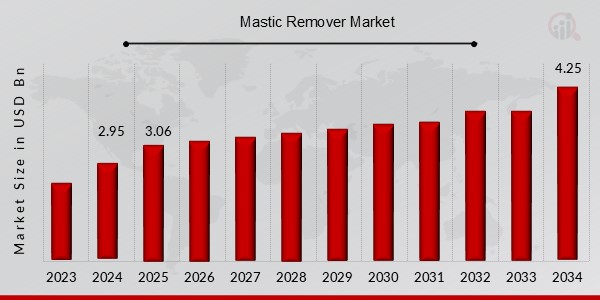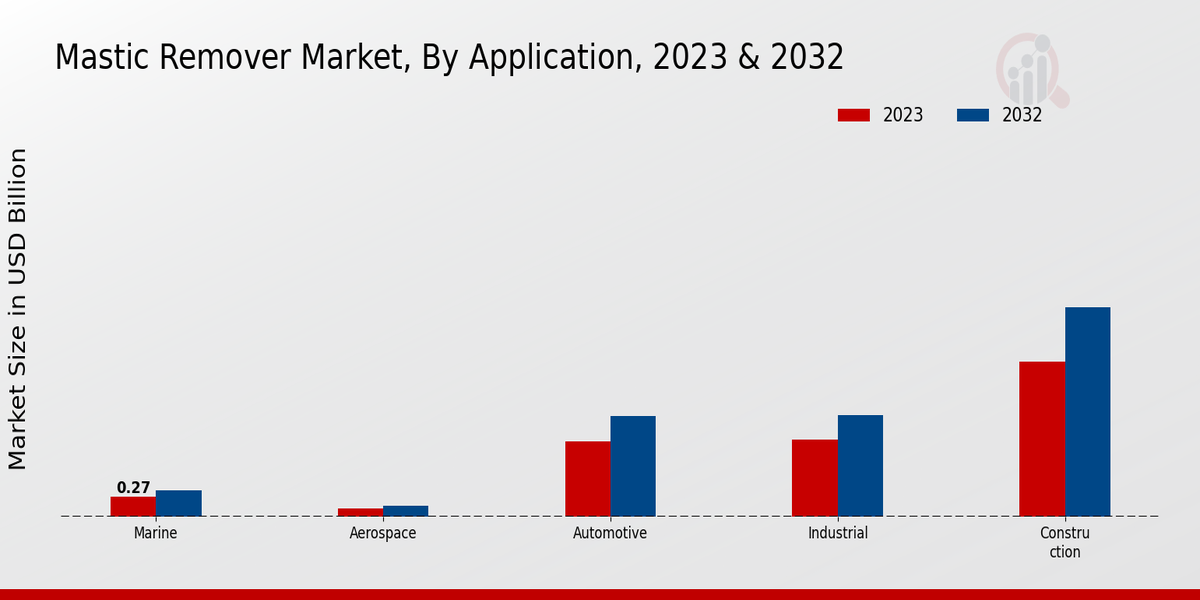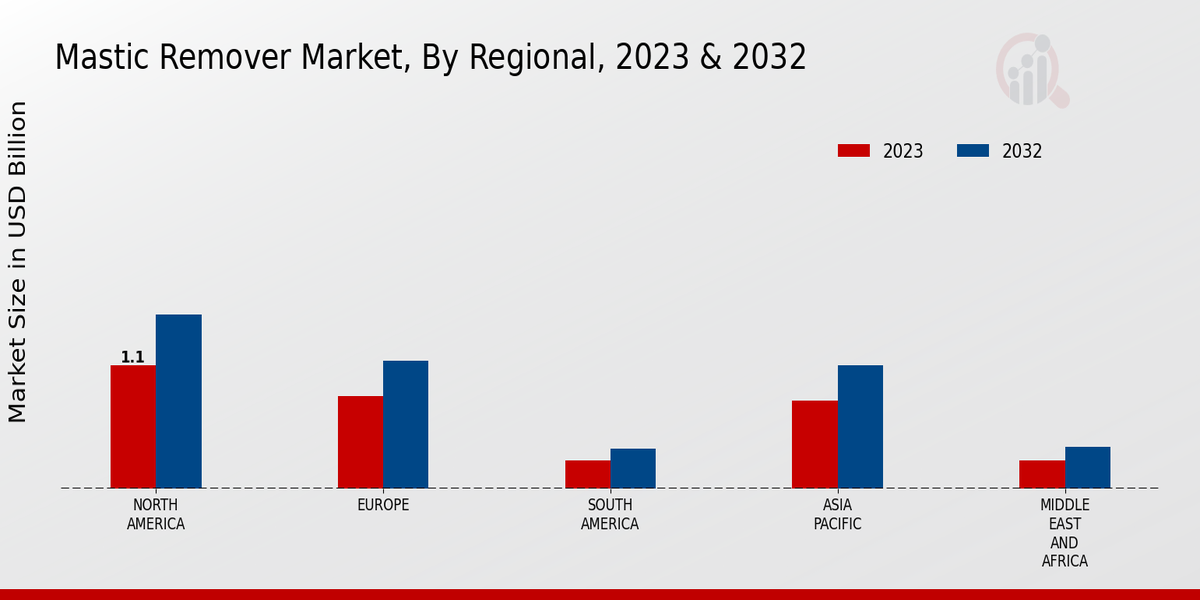Global Mastic Remover Market Overview
The Mastic Remover Market Size was estimated at 2.95 (USD Billion) in 2024. The Mastic Remover Industry is expected to grow from 3.06 (USD Billion) in 2025 to 4.25 (USD Billion) by 2034. The Mastic Remover Market CAGR (growth rate) is expected to be around 3.7% during the forecast period (2025 - 2034).
Key Mastic Remover Market Trends Highlighted
The mastic remover market is witnessing a surge in demand due to the increasing popularity of epoxy floors and adhesives, which require specialized removal solutions. The growing construction industry, particularly in emerging economies, has further fueled the market growth.
Key market drivers include advancements in chemical technologies, leading to the development of eco-friendly and powerful mastic removers. Additionally, the increasing emphasis on safety and environmental regulations has fostered the demand for non-toxic and biodegradable formulations.
Recent trends indicate a shift towards water-based mastic removers, offering reduced odor and environmental impact. Additionally, the emergence of bio-based removers derived from renewable resources aligns with the growing consumer preference for sustainable products.
Opportunities for growth lie in exploring niche applications, such as specialized removers for removing mastic from delicate surfaces or removing stubborn adhesive residues. Innovations in packaging and dispensers, enhancing user convenience and safety, also hold promise for market expansion.

Source Primary Research, Secondary Research, MRFR Database and Analyst Review
Mastic Remover Market Drivers
Rising Demand for Adhesives and Sealants
The growing construction industry is a major driver of the Mastic Remover Market Industry. Adhesives and sealants are essential components in construction projects, and their increasing use is fueling the demand for mastic removers. Mastic removers are used to remove excess adhesives and sealants from surfaces, ensuring a clean and professional finish. The increasing adoption of adhesives and sealants in various industries, including automotive, aerospace, and electronics, is also contributing to the growth of the mastic remover market.
As the construction industry continues to expand, the demand for mastic removers is expected to rise in tandem, creating significant growth opportunities for market players.
Advancements in Technology
Technological advancements are another key driver of the Mastic Remover Market Industry. The development of new and improved mastic remover formulations is enhancing the efficiency and effectiveness of these products. Manufacturers are investing in research and development to create mastic removers that are faster-acting, more environmentally friendly, and safer to use. These advancements are making mastic removers more appealing to consumers and driving market growth.
Additionally, the introduction of innovative application methods, such as sprayable and gel-based removers, is further expanding the market's reach.
Increasing Environmental Awareness
Growing environmental concerns are shaping the Mastic Remover Market Industry. Consumers are becoming more aware of the environmental impact of chemical products, and they are seeking eco-friendly alternatives. Manufacturers are responding to this demand by developing mastic removers that are biodegradable and non-toxic. These eco-friendly removers are gaining popularity in various industries, including construction, automotive, and manufacturing.
The increasing adoption of sustainable practices is expected to drive the growth of the eco-friendly mastic remover segment in the coming years.
Mastic Remover Market Segment Insights
Mastic Remover Market Application Insights
The Mastic Remover Market is divided into segments, according to application and region. In terms of the application segment, the construction segment is likely to witness the most growth in 2023 and is anticipated to continue leading. The growth is attributed to the increased number of residential and commercial projects being undertaken. However, the automotive segment is expected to grow steadily from 2024 to 2032, which can be explained by the rising production of automobiles and the importance of maintenance and occasional repair of vehicles.
Same goes for the industrial segment, as the increased usage of the remover is to occur in various applications, from mining and manufacturing to oil and gas. The marine segment is expected to grow at a slower pace since the demand can currently be mostly seen in the broad spectrum of ship-building and maintenance. Finally, the aerospace sector is likely to grow at the slowest rate due to the many regulations and safety precautions in the industry. Concerning the revenue, both for 2023 and 2032, the revenue is expected to constitute USD 2.75 billion and USD 3.81 billion, respectively.
In addition, Asia-Pacific is likely to have the highest market share in 2023, which will be increasing until 2032. The market growth is propelled by the increased number of construction and the rising amount of mastic remover used in other industries in China and India. The market is, however, extremely competitive, with a large number of players, as well as the presence of two types of competitors, namely, and regional. The key players, such as 3M, Henkel, Sika, Bostik, and Dow, are concentrating on developing new products and expanding to less developed regions.
At the same time, there is a considerable amount of regional small and medium enterprise players focused on niche applications of their product.

Source Primary Research, Secondary Research, MRFR Database and Analyst Review
Mastic Remover Market End User Insights
The End User segment of the Mastic Remover Market holds a significant share, driven by the increasing demand for mastic removers in various industries. Professional remodelers constitute a major portion of the market, utilizing mastic removers for construction and renovation projects. The growing construction industry, particularly in developing regions, is fueling the demand for mastic removers among professional remodelers. Do-It-Yourselfers also contribute to the market growth, leveraging mastic removers for home improvement and repair tasks.
The increasing popularity of DIY projects and the availability of user-friendly mastic removers have expanded the market reach. Industrial manufacturers represent another key segment, utilizing mastic removers for cleaning and maintenance purposes in various industries, including automotive, aerospace, and electronics. With the increasing focus on operational efficiency and safety, industrial manufacturers are adopting advanced mastic removers to enhance productivity and minimize downtime.
Mastic Remover Market Substrate Type Insights
The Mastic Remover Market is segmented based on Substrate Type into Ceramic Tile, Porcelain Tile, Natural Stone, Concrete, and Wood. Among these, the Ceramic Tile segment held the largest market share in 2023 and is expected to continue its dominance throughout the forecast period. The growth of this segment can be attributed to the increasing use of ceramic tiles in residential and commercial construction projects. Porcelain Tile is another significant segment, owing to its durability and resistance to stains and scratches. The Natural Stone segment is expected to witness steady growth due to the rising demand for natural and eco-friendly materials in construction.
Concrete and Wood are also expected to contribute to the growth of the Mastic Remover Market, as they are widely used in various industrial and construction applications.
Mastic Remover Market Mastic Type Insights
The Mastic Remover Market is segmented by mastic type into acrylic latex, silicone, polyurethane, and epoxy. Among these segments, acrylic latex is expected to hold the largest market share in 2023, accounting for over 40% of the market revenue. The growth of this segment is attributed to the increasing use of acrylic latex mastic in construction applications, owing to its ease of application, flexibility, and durability. Silicone is another significant segment, which is expected to witness a steady growth rate during the forecast period.
The demand for silicone mastic is primarily driven by its high resistance to temperature extremes, UV radiation, and chemicals, making it suitable for use in various industrial and automotive applications. Polyurethane and epoxy mastics are also gaining popularity due to their superior bonding strength and adhesion properties, which make them ideal for heavy-duty applications.
Mastic Remover Market Product Format Insights
The Mastic Remover Market is segmented by product format into liquid, paste, gel, and aerosol. Among these, the liquid format held the largest market share in 2023 and is expected to maintain its dominance throughout the forecast period. The Mastic Remover Market revenue from the liquid segment is projected to reach USD 3.81 billion by 2032, exhibiting a CAGR of 3.69% during the forecast period. The high demand for liquid mastic removers can be attributed to their ease of application, versatility, and effectiveness in removing various types of mastic adhesives.
Liquid removers are commonly used in construction, automotive, and industrial applications. The paste format is another popular product format, particularly in applications where a thicker consistency is required. Paste removers offer better adhesion to vertical surfaces and are often used for removing stubborn mastic residues. Gel removers, on the other hand, provide a balance between liquid and paste formats, offering both ease of application and effective removal of mastic adhesives. Aerosol removers are primarily used in applications where quick and convenient removal is necessary.
They are often preferred for small-scale projects or hard-to-reach areas.
Mastic Remover Market Regional Insights
The regional segmentation of the Mastic Remover Market offers insights into the market's performance and growth potential across different geographic regions. North America is expected to hold a significant share of the market in 2023, owing to the presence of key players and the high demand for mastic removers in the construction and automotive industries. Europe is another major market, driven by the increasing adoption of eco-friendly mastic removers in various applications. The APAC region is projected to witness substantial growth over the forecast period due to the rising construction activities and the growing awareness of green building practices.
South America and MEA are emerging markets with untapped potential, presenting opportunities for market expansion.

Source Primary Research, Secondary Research, MRFR Database and Analyst Review
Mastic Remover Market Key Players And Competitive Insights
Major players in Mastic Remover Market industry are constantly engaged in research and development to introduce innovative products with enhanced features and performance. Leading Mastic Remover Market players are focused on expanding their product portfolio and geographical reach through acquisitions, mergers, and partnerships. The Mastic Remover Market is characterized by intense competition, with several key players vying for market share. These players are investing heavily in marketing and promotional activities to increase their brand visibility and attract customers. The competitive landscape is expected to remain dynamic, with new entrants and disruptive technologies constantly emerging.
Henkel AG & Co. KGaA is a leader in the adhesive and sealant industry, with a strong presence in the Mastic Remover Market. The company offers a wide range of mastic removers under its Loctite brand, catering to various industrial and consumer applications. Henkel AG & Co. KGaA has a comprehensive distribution network and a strong brand reputation, which gives it a competitive edge in the market.
3M is a diversified technology company with a presence in various industries, including the Mastic Remover Market. The company offers a range of mastic removers under its Scotch-Brite brand, designed for use in automotive, marine, and industrial applications. 3M's strong research and development capabilities and extensive product portfolio position it as a leading player in the Mastic Remover Market. The company focuses on innovation and the development of sustainable products to meet the evolving needs of customers.
Key Companies in the Mastic Remover Market Include
Mastic Remover Market Industry Developments
Rising construction activities in emerging economies, increasing use of adhesives and sealants in various industries, and growing demand for eco-friendly and sustainable mastic removers are driving the market growth.
Recent news developments include Henkel's launch of a new biodegradable mastic remover under the Loctite brand and the acquisition of Bostik by Arkema, expanding its portfolio of construction adhesives and sealants. The market is also witnessing the emergence of solvent-free and water-based mastic removers, catering to the growing demand for environmentally friendly products.
Mastic Remover Market Segmentation Insights
Mastic Remover Market Application Outlook
- Construction
- Automotive
- Industrial
- Marine
- Aerospace
Mastic Remover Market End User Outlook
- Professional Remodelers
- Do-It-Yourselfers
- Industrial Manufacturers
Mastic Remover Market Substrate Type Outlook
- Ceramic Tile
- Porcelain Tile
- Natural Stone
- Concrete
- Wood
Mastic Remover Market Mastic Type Outlook
- Acrylic Latex
- Silicone
- Polyurethane
- Epoxy
Mastic Remover Market Product Format Outlook
Mastic Remover Market Regional Outlook
- North America
- Europe
- South America
- Asia Pacific
- Middle East and Africa
|
Report Attribute/Metric
|
Details
|
| Market Size 2024 |
2.95 (USD Billion)
|
| Market Size 2025 |
3.06 (USD Billion)
|
| Market Size 2034 |
4.25 (USD Billion)
|
|
Compound Annual Growth Rate (CAGR)
|
3.7% (2025 - 2034)
|
|
Report Coverage
|
Revenue Forecast, Competitive Landscape, Growth Factors, and Trends
|
|
Base Year
|
2024 |
|
Market Forecast Period
|
2025 - 2034 |
|
Historical Data
|
2020 - 2024 |
|
Market Forecast Units
|
USD Billion
|
|
Key Companies Profiled
|
Mapei S.p.A., Dow, Bostik, Ashland Holdings Inc., Sika AG, Huntsman Corporation, RPM International, Trelleborg AB, Avery Dennison Corporation, Henkel, H.B. Fuller, BASF, 3M
|
|
Segments Covered
|
Application, End User, Substrate Type, Mastic Type, Product Format, Regional
|
|
Key Market Opportunities
|
Growing construction industry
Increasing home renovation activities
Demand for ecofriendly products
Rising awareness of health hazards Technological advancements
|
|
Key Market Dynamics
|
Growing construction industry
Increasing demand from DIY sector
Rising awareness of environmental impact Technological advancements
Expansion of commercial sector
|
|
Countries Covered
|
North America, Europe, APAC, South America, MEA
|
Frequently Asked Questions (FAQ) :
The Mastic Remover Market is anticipated to reach a valuation of 2.95 Billion USD in 2024.
The Mastic Remover Market is projected to expand at a CAGR of 3.7% from 2025 to 2034.
North America is expected to dominate the Mastic Remover Market in 2024.
Mastic removers are primarily used in the construction and automotive industries for removing adhesives and sealants.
Key competitors in the Mastic Remover Market include 3M, Henkel, and Sika.
The Mastic Remover Market is anticipated to reach a valuation of 4.25 Billion USD by 2034.
Asia Pacific is expected to experience the highest growth rate in the Mastic Remover Market from 2025 to 2034.
Increasing demand from the construction and automotive industries is a major factor driving the growth of the Mastic Remover Market.
Environmental regulations and the availability of substitutes pose challenges to the Mastic Remover Market.
Technological advancements and the expansion of the construction industry present growth opportunities for the Mastic Remover Market.
















